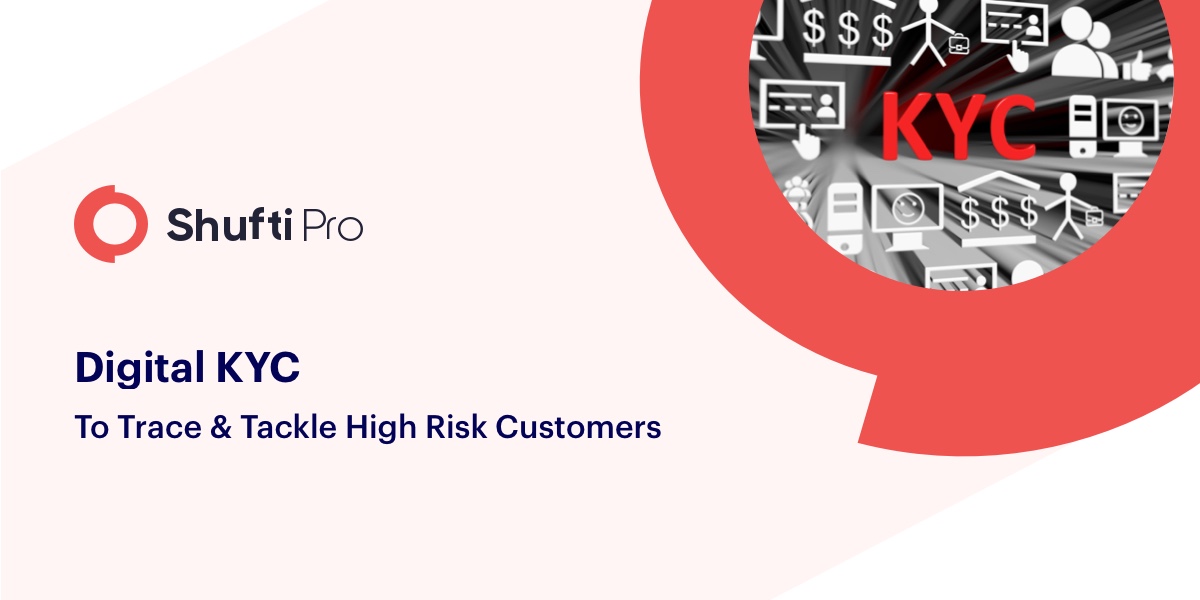Digital KYC to Trace and Tackle High-Risk Customers

Customers are the assets and building blocks of any business. Customers are responsible for taking businesses to the next level or destroying it to rubble. That is why it very crucial to know who you are dealing with. Know your customer is the procedure to identify and verify customers to check if they are real and not fraudsters or indulged in any illicit activity that can cause a threat to business. It is a process to check the background of customers and analyze the risk factors associated with them.
The fundamental idea behind the introduction of KYC in organizations was to find a way that can protect the organizations from fraudsters and criminals and doesn’t involve penalizing the innocents at the same time. The KYC process is a standard procedure to verify the customers at the time of onboarding. However, with strict regulations coming into the light, KYC isn’t limited to the verification of the customers, instead, it is now to continuously analyze the customer behavior to look out for suspicious activities and illicit transactions. It is used for the following purposes:
- To curb fraud schemes
- To mitigate scam scandals
- To put a halt on money laundering
- To hinder illicit fraud transfer and
- To identify high-risk customers by enhanced due diligence
Need for KYC to Identify High-Risk Customers:
The KYC laws were introduced as the section of the Patriot Act passed in 2001 after the incident of 9/11 to deter terrorist activities and criminal funding. The section of this act concerned with the financial transactions inserted some new policies in addition to those of “The Bank of Secrecy Act of 1970.” These requirements regulated the banks and other financial institutions. As per the Patriot Act, the organizations dealing with finance are required to meet three main requirements in order to comply with KYC regulations:
- Customer Identification Program (CIP)
- Customer Due Diligence (CDD)
- Enhanced Due Diligence (EDD)
High-Risk Customer Identification Program (CIP)
The customer identification program is a significant component of the KYC process in which the organizations are obliged to ask customers to provide their identification information. It is to verify the identity of the customer who wishes to carry out a financial transaction with a particular bank. The CIP requirement was made compulsory in 2003 for the financial institutions to develop and incorporate customer identification programs into their secrecy policies to meet anti-money laundering (AML) compliance.
Every institution has its own CIP processes depending on the size and type of the institute. That’s why they may require different documents for verification. Generally, driving license and passports the most commonly required document by the banks. Regardless, some other documents may include:
- Utility bills
- Financial references or statements
- Information from a consumer reporting agency or public database
No matter what document or information of the individuals and business is asked, it is to check their authenticity that they are not fake or fall in any prohibited lists so that fake customers and customers at high-risk can be filtered.
High-Risk Customers Due Diligence
Customer due diligence covers multiple aspects of customer verification and identification. For secure onboarding of clients, it is essential to identify the future risks that can arise due to some customers – the reason why customer due diligence is conducted. While performing due diligence, the significant goal is to analyze customer behavior and predict the type of transaction pattern that the customer is most likely to follow. In an evolving regulatory climate, mobile identity verification can be of great help. It helps organizations in identifying suspicious behavior and assigning a risk rating to customers to identify the customers that can be threatening for organizations and how often their accounts will be monitored.
The regulatory agencies have set no particular standards or methodologies for conducting customer due diligence leaving the institutions with an open choice to follow their own tools and devices. Many organizations demand a lot of information during the process including banking references, previous financial statements, salary slips, occupation, source of funds, etc. The purpose of this information is to analyze the background and behavior of the customer to predict future risks that may be linked to the customer.
All this hassle because FinCEN has strictly imposed this requirement on the financial institutes to immediately report any threatening or suspicious activity. And you can’t do it efficiently unless you know your customer behavior and history.
Enhanced Due Diligence (EDD) for High-Risk Customers:
Enhanced due diligence (EDD) is an advanced and more comprehensive set of KYC procedures for high-risk customers, exhibiting irregular transaction behavior or ambiguous sources of origin. The customers classified under the high-risk category after the Customer Due Diligence (CDD) process are more likely prone to money laundering and illegal funding of terrorists and criminals. They need to be monitored continuously. Considering the trend of such illicit transactions, the USA Patriot Act strictly dictates the institutions that they
“shall establish appropriate, specific, and, where necessary, enhanced due diligence policies, procedures, and controls that are reasonably designed to detect and report instances of money laundering through those accounts.”
The EDD process includes verifying ultimate beneficial ownership information (UBO) and identifying politically exposed persons (PEPs). Monitoring the transactions is also one of the fundamentals of the EDD process.
High-Risk Customer Types
High-risk customers include, but are not restricted to:
- Customers linked to higher-risk countries
- Customers from High-Risk Business sectors
- Customers have complex beneficial ownership structures
- Unusual account activity
- Lack of an obvious economic or lawful purpose
- Politically Exposed Persons (PEPs)
- Customers who are close relatives of PEPs
- Entities having Politically Exposed Person (PEPs) as ultimate beneficial owners
- Customers with a shaky reputation as per available information
- Accounts of no- face- to- face- customers, etc.
- Non- resident Customers doing business in another country
- Accounts of Cash intensive business such as accounts of Bullion dealers, jewelers, real estate developers, etc.
High-risk Customers-Venomous for the Business:
High-risk customers are identified from the customer provided by using digital identity verification solutions. Such customers are monitored perpetually for the potential suspicious activities in their accounts so that no forgery can take place like money laundering, account takeover, identity theft, etc. Such customers can be a poisonous threat to business until they exist in the system. Various AI-powered Saas products offer inputs that are useful for the monitoring systems of the business to filter such AML high-risk customers that pose a threat of money laundering. Such a risk management framework will business in assessing customer risk.
Digital KYC Checks- From Weeks to Seconds:
It is a documented fact that customers are the assets of any organization. Digital KYC is what the institutions need in this era of technology. Based on the principles of automation, the eKYC process can simultaneously execute multiple steps. It reduces the keystroke time, cost and human effort. The process that could take hours and days for an individual can be cut down to seconds with the help of AI-powered solutions and tools. With the use of intelligent KYC verification, the businesses can onboard a more secure clientele and that too with real-time verification, coping up with the regulatory complexities at the same time.
With the world moving into the digital sphere, customer convenience is even more important for any business. The manual KYC process is quite a time consuming and costly process. Clients get exhausted as it takes weeks or even months to onboard a customer. This cumbersome procedure even ends up losing customers as they move to other platforms during this time taking procedure. It is evident now that digital KYC doesn’t only help to identify any customer but helps to filter out customers that have some traits putting them as high-risk customers so that businesses are vigilant while dealing with them. Also, due to the digital revolution, the concept of global onboarding is becoming common which requires more fast and convenient verification and onboarding process.
Perks of Using Digital KYC Solution:
To end up negative customer experience digital identity verification solution has achieved a milestone. Following are some of the benefits that come up with using the digital identity verification solutions for KYC:
-
Demit Frauds and Scams
Using digital KYC can decrease the risk of frauds like identity theft, credit card fraud, and onboarding high-risk clients.
-
Increase Security
It’s more important than ever to verify the identities of customers due to an increased risk of terrorist funding and money laundering and other cybercrimes.
-
Ensure Accuracy
Digital KYC solutions provide a seamless experience where there are lesser chances of errors and omissions.
-
Provide Better Customer Experience
Digital KYC provides a better customer experience as it takes no time for the whole authentication process.
In a nutshell, digital KYC clubbed with artificial intelligence is crucial to identify and tackle with high-risk customers that can bring along various dangers for businesses. Business can end up paying hefty fines due to such customers or owners end up losing their businesses. Digital KYC simplifies identity verification for an online business that plays a vital role in this area. In an evolving regulatory climate, mobile identity verification can be of great help. In the coming years, it will continue to morph with surprising speed.










